仁爱版八年级英语(上)教学设计Unit4Topic2SectionB(模版)
- 格式:docx
- 大小:59.40 KB
- 文档页数:39
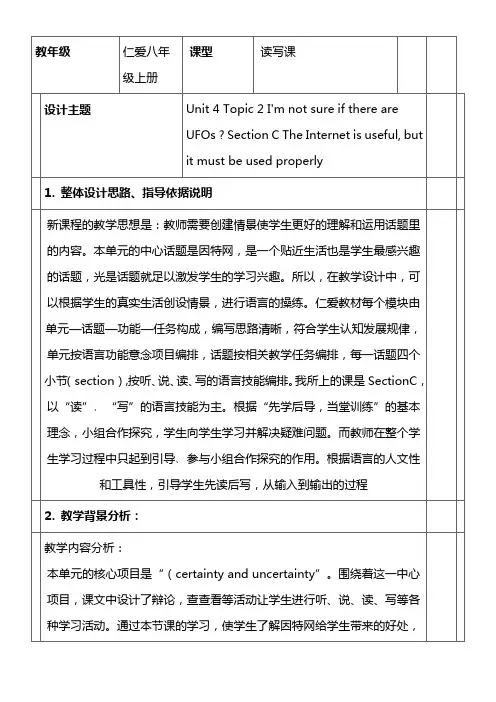
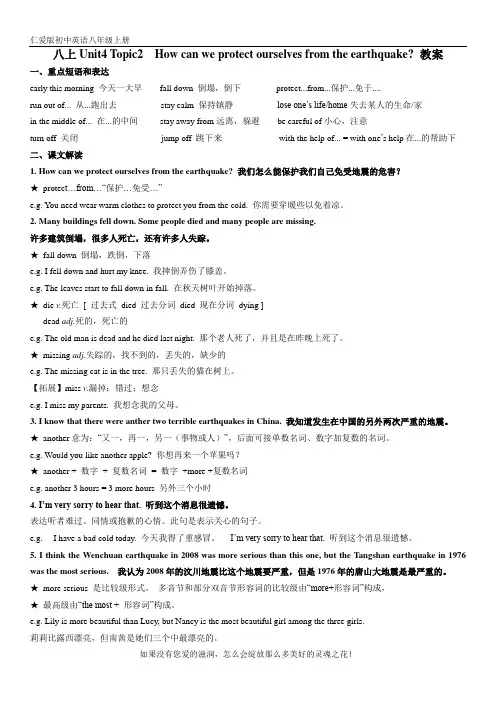
八上Unit4 Topic2 How can we protect ourselves from the earthquake? 教案一、重点短语和表达early this morning 今天一大早fall down 倒塌,倒下protect...from...保护...免于....run out of... 从...跑出去stay calm 保持镇静lose one’s life/home失去某人的生命/家in the middle of... 在...的中间stay away from远离,躲避be careful of小心,注意turn off 关闭jump off 跳下来with the help of... = with one’s help在...的帮助下二、课文解读1. How can we protect ourselves from the earthquake? 我们怎么能保护我们自己免受地震的危害?★protec t…from…“保护…免受…”e.g. You need wear warm clothes to protect you from the cold. 你需要穿暖些以免着凉。
2. Many buildings fell down. Some people died and many people are missing.许多建筑倒塌,很多人死亡,还有许多人失踪。
★fall down 倒塌,跌倒,下落e.g. I fell down and hurt my knee. 我摔倒弄伤了膝盖。
e.g. The leaves start to fall down in fall. 在秋天树叶开始掉落。
★die v.死亡[ 过去式died 过去分词died 现在分词dying ]dead adj.死的,死亡的e.g. The old man is dead and he died last night. 那个老人死了,并且是在昨晚上死了。
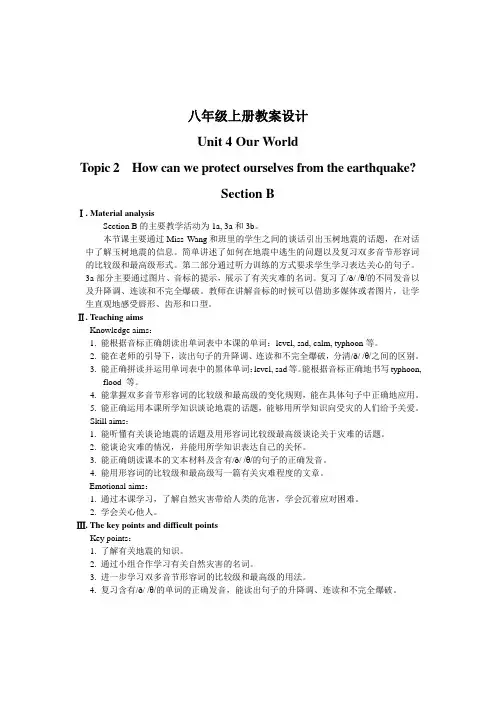
八年级上册教案设计Unit 4 Our WorldTopic 2 How can we protect ourselves from the earthquake?Section BⅠ. Material analysisSection B的主要教学活动为1a, 3a和3b。
本节课主要通过Miss Wang和班里的学生之间的谈话引出玉树地震的话题,在对话中了解玉树地震的信息。
简单讲述了如何在地震中逃生的问题以及复习双多音节形容词的比较级和最高级形式。
第二部分通过听力训练的方式要求学生学习表达关心的句子。
3a部分主要通过图片、音标的提示,展示了有关灾难的名词。
复习了/ð/ /θ/的不同发音以及升降调、连读和不完全爆破。
教师在讲解音标的时候可以借助多媒体或者图片,让学生直观地感受唇形、齿形和口型。
Ⅱ. Teaching aimsKnowledge aims:1. 能根据音标正确朗读出单词表中本课的单词:level, sad, calm, typhoon等。
2. 能在老师的引导下,读出句子的升降调、连读和不完全爆破,分清/ð/ /θ/之间的区别。
3. 能正确拼读并运用单词表中的黑体单词:level, sad等。
能根据音标正确地书写typhoon,flood 等。
4. 能掌握双多音节形容词的比较级和最高级的变化规则,能在具体句子中正确地应用。
5. 能正确运用本课所学知识谈论地震的话题,能够用所学知识向受灾的人们给予关爱。
Skill aims:1. 能听懂有关谈论地震的话题及用形容词比较级最高级谈论关于灾难的话题。
2. 能谈论灾难的情况,并能用所学知识表达自己的关怀。
3. 能正确朗读课本的文本材料及含有/ð/ /θ/的句子的正确发音。
4. 能用形容词的比较级和最高级写一篇有关灾难程度的文章。
Emotional aims:1. 通过本课学习,了解自然灾害带给人类的危害,学会沉着应对困难。

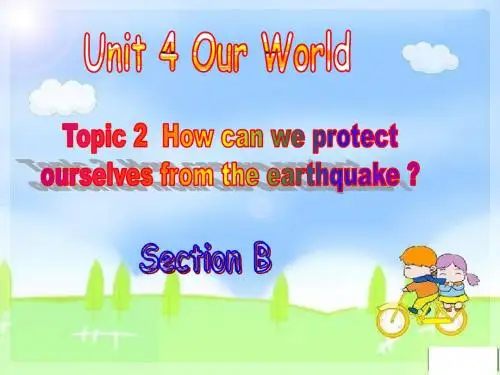

八年级上册Unit 4 Our worldTopic 2 How can we protect ourselves from the earthquake?一.重点句型:Section A1.A terrible earthquake struck Qinghai.一场可怕的地震袭击了青海。
strike意为“侵袭,爆发”,过去式struck。
The lightning struck again. 雷电再次闪击。
2.Many buildings fell down.Some people died and many people are missing. 许多建筑倒塌,很多人死亡,还有许多人失踪。
fall down 倒塌,跌倒,下落;I fell down and hurt my knee. 我摔倒弄伤了膝盖。
3. And I know that there were anther two terrible earthquakes in China. 我还直到发生在中国的另外两次严重的地震。
another意为:“又一,再一,另一(事物或人)”,后面可接单数名词、数字加复数的名词。
another + 数字+ 复数名词= 数字+more +复数名词;Would you like another apple?你想再来一个苹果吗?another 3 hours = 3 more hours 另外三个小时;4. I’m very sorry to hear that. 听到这个消息很遗憾。
表达听者难过、同情或抱歉的心情。
此句是表示关心的句子。
-----I have a bad cold today. 今天我得了重感冒。
----- I’m very sorry to hear that. 听到这个消息很遗憾。
5. I think the Wenchuan earthquake in 2008 was more serious than this one,but theTangshan earthquake in 1976 was the most serious. 我认为2008年的汶川地震比这个地震要严重,但是1976年的唐山大地震是最严重的。
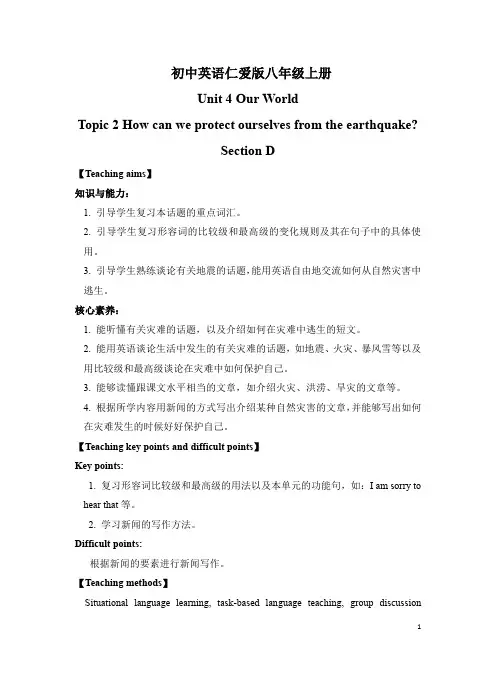
初中英语仁爱版八年级上册Unit 4 Our WorldTopic 2 How can we protect ourselves from the earthquake?Section D【Teaching aims】知识与能力:1. 引导学生复习本话题的重点词汇。
2. 引导学生复习形容词的比较级和最高级的变化规则及其在句子中的具体使用。
3. 引导学生熟练谈论有关地震的话题,能用英语自由地交流如何从自然灾害中逃生。
核心素养:1. 能听懂有关灾难的话题,以及介绍如何在灾难中逃生的短文。
2. 能用英语谈论生活中发生的有关灾难的话题,如地震、火灾、暴风雪等以及用比较级和最高级谈论在灾难中如何保护自己。
3. 能够读懂跟课文水平相当的文章,如介绍火灾、洪涝、旱灾的文章等。
4. 根据所学内容用新闻的方式写出介绍某种自然灾害的文章,并能够写出如何在灾难发生的时候好好保护自己。
【Teaching key points and difficult points】Key points:1. 复习形容词比较级和最高级的用法以及本单元的功能句,如:I am sorry to hear that等。
2. 学习新闻的写作方法。
Difficult points:根据新闻的要素进行新闻写作。
【Teaching methods】Situational language learning, task-based language teaching, group discussionteaching.【Teaching procedures】Lead in:1. Get students ready for learning.2. Invite students to report his/her homework.3. Show the pictures, make a short conversation.A: The __________ is ________.B: I think the ________ is _________ than the ________.C: Yes, but the _________ is __________ of the three.Presentation:1. Give students 3 minutes to read through Sections A-C. Ask them to underline or write down the key points they think.2. Provide 1 minute for students to classify their notes.3. Make a competition. Divide students into three parts. One part writes down the new words, and another part writes down the new sentences. The last part aims to write down the phrases. There are three groups in each part.4. Ask students to look at the blackboard and check whether they can remember all of these on the blackboard.5. Show “Grammar and Functions” to students. And check the answers.6. Organize students to read “Grammar and Functions”.7. Give explanations if necessary.Presentation:1. Ask students to read the passage in 1 carefully.2. Show the first table on Page 96 to students. Make sure every student knows the meaning of the table. Complete the table.3. Invite students to share their answers.4. Listen and find out important phrases. Learn the key points.1) five million2) with the help of …3) the whole nation4) rebuild their homes5) return to normal life6) be able toConsolidation:1. Show the table in 2 to students.2. Ask students to write a piece of news similar to 1 about Tangshan earthquake. Remind students to pay attention to the elements in news.3. Invite students to share their news in class.4. Organize students to choose the best announcer and the best team.5. Praise the best announcers.6. Finish Project. Ask your friends how they feel about children from disaster areas.7. Make a short report to your class about your survey.8. Write a letter to the children in disaster areas. Give your comfort, concern and best wishes to them.9. Do some exercises.Summary:We learn:1. 复习形容词比较级和最高级的用法以及本单元的功能句。
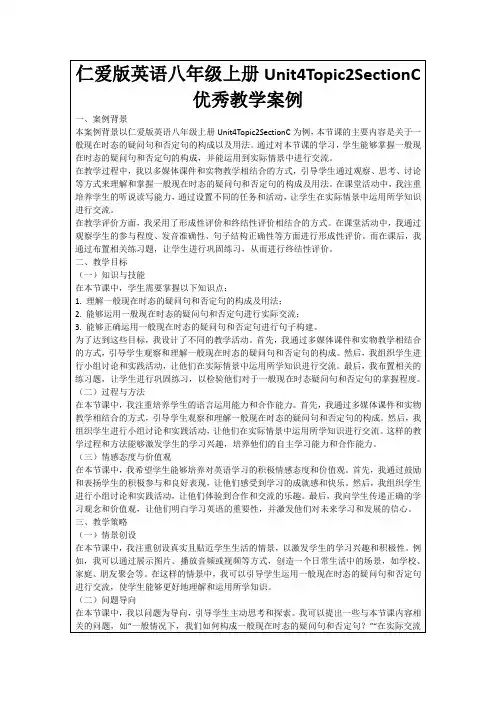
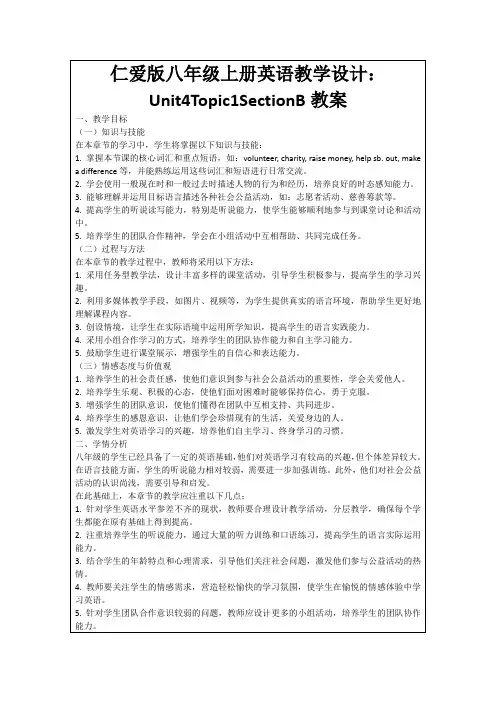
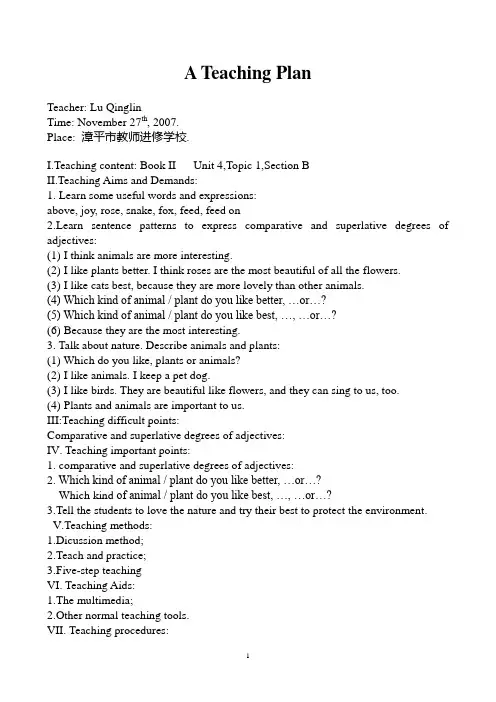
A Teaching PlanTeacher: Lu QinglinTime: November 27th, 2007.Place: 漳平市教师进修学校.I.Teaching content: Book II Unit 4,Topic 1,Section BII.Teaching Aims and Demands:1. Learn some useful words and expressions:above, joy, rose, snake, fox, feed, feed on2.Learn sentence patterns to express comparative and superlative degrees of adjectives:(1) I think animals are more interesting.(2) I like plants better. I think roses are the most beautiful of all the flowers.(3) I like cats best, because they are more lovely than other animals.(4) Which kind of animal / plant do you like better, …or…?(5) Which kind of animal / plant do you like best, …, …or…?(6) Because they are the most interesting.3. Talk about nature. Describe animals and plants:(1) Which do you like, plants or animals?(2) I like animals. I keep a pet dog.(3) I like birds. They are beautiful like flowers, and they can sing to us, too.(4) Plants and animals are important to us.III:Teaching difficult points:Comparative and superlative degrees of adjectives:IV. Teaching important points:1. comparative and superlative degrees of adjectives:2. Which kind of animal / plant do you like better, …or…?Which kind of animal / plant do you like best, …, …or…?3.Tell the students to love the nature and try their best to protect the environment. V.Teaching methods:1.Dicussion method;2.Teach and practice;3.Five-step teachingVI. Teaching Aids:1.The multimedia;2.Other normal teaching tools.VII. Teaching procedures:●课后反思:课堂练习一、根据句子意思填空,首字母已给出。
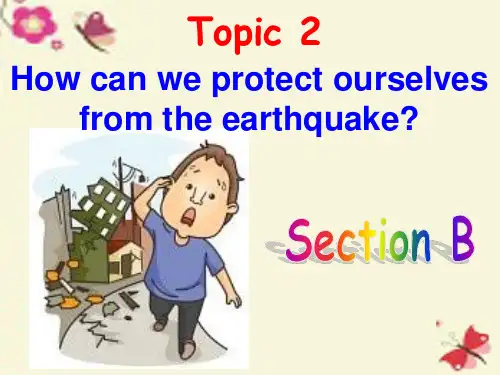
UNIT 4 Our WorldTOPIC 2 How can we protect ourselves from theearthquake?Section B教案教学目标1、知识与能力目标:本模块主要讲授的是实义动词的一般过去式的否定形式didn’t 的用法。
在第一单元中通过运用一般现在时对生活习惯的描述以及实义动词一般过去时的否定形式对于过去某一天没有发生的活动的描述来进行对比,帮助学生理解否定式的含义及用法。
在通过阅读、歌曲及游戏等活动来进一步复习和巩固上一单元中所呈现的重点语言知识。
2、情感态度目标:培养学生的美好情感。
3、能够听懂、会说、会读词汇:protect,save,useful,earth,waste,reuse,energy……4、能够读懂课文对话,掌握use和should的用法。
5、了解字母组合“th”的发音。
技能目标:掌握与use和should相关的句型及用法。
情感态度:了解一些保持地球的行为。
教学重点能通过练习、运用等活动使学生能够掌握地震对人类的伤害以及怎样去防范这种伤害是本模块的重点。
本模块涉及到的语法项目比较多,有一般现在时及其第三人称单数、一般过去式及实义动词的否定式。
使学生能正确的运用进行语言的交际是本模块的难点。
在学习了单词的基础上,以单词为载体,进行主要句型的学习,并了解其中的语法现象,根据具体情境,学会交流对话,侧重句型语法学习,交际意向和课外拓展为重点。
教学方法游戏,音频,情景教学法,Pair-work两人小组活动,Group-work小组活动,多媒体辅助教学。
教学难点学生处于初中阶段,对英语有了初步了解,词汇储备较少,对学生的要求重点是在会读会说的基础上,能掌握一些基本单词的拼写和造句,了解一定的语法内涵,与人进行简单沟通交流。
课前准备录音机、磁带、单词卡片、VCD二、教学步骤Grammar timeKey sentences:We use...to...We should ...同学之间展开小练习相互提问与回答,共同锻炼与进步。
仁爱版英语精品资料(精修版)八年级上册教案设计Unit 4 Our WorldTopic 2 How can we protect ourselves from the earthquake?Section DⅠ. Material analysis本节课是本话题的最后一节课,主要通过Grammar、Functions 来复习本话题的语法重点:双多音节形容词的比较级和最高级。
通过Section A, B对形容词比较级和最高级的讲解、练习及在真实语境中熟练应用,学生基本上掌握了它的变化规则和在句子中的应用。
通过本课的复习巩固加深学生的记忆。
本节课还会通过新闻的形式介绍汶川地震,要求学生了解汶川地震,并掌握新闻写作的要素,通过本课学习,学生能够模仿汶川地震的新闻,根据新闻写作的要素,写一篇新闻。
Ⅱ. Teaching aimsKnowledge aims:1. 引导学生复习本话题的重点词汇,并能根据音标正确地拼读下列词汇:million, whole,nation等。
能正确地读出句子的语调。
2. 引导学生复习总结本话题的单词,并能够正确拼写本话题的黑体词汇。
3. 引导学生复习形容词的比较级和最高级的变化规则及其在句子当中的具体使用。
4. 引导学生熟练谈论有关地震的话题,能用英语自由地交流如何从自然灾害中逃生。
Skill aims:1. 能听懂有关灾难的话题,以及介绍如何在灾难中逃生的短文。
2. 能够将本单元所学内容和以前所学知识相结合,能用英语谈论在生活中发生的有关灾难的话题,如地震、火灾、暴风雪等以及用比较级和最高级谈论在灾难中如何保护自己。
3. 能够读懂跟课文水平相当的文章,如介绍火灾、洪涝、旱灾的文章等。
4. 根据所学内容用新闻的方式写出介绍某种自然灾害的文章,并能够写出如何在灾难发生的时候好好保护自己。
Emotional aims:1. 通过本课的学习,学生在遇到学习、生活方面的困难时候能够冷静面对。
Unit 4 Our WorldTopic 2 How can we protect ourselves from the earthquake?教学内容分析及课时分配建议:本单元以Our World 为主题。
第二话题主要围绕玉树地震,地震中如何保护自己等话题展开。
同时学习表达安慰,关心等的功能句。
本话题的主要语法是:多音节和部分双音节形容词比较级和最高级的变化规律。
主要句型有:The mobile phone is more useful than the telephone., The computer is the most useful of the three., The safest place is under a strong table or desk., Was it serious?, I’m very sorry to hear that., Don’t worry.等。
语音版块复习字母i,o和字母组合oo,ou,ow,or,ai在单词中的发音规则;区分/θ/和/ ð/的发音,学习降调,继续训练连读和不完全爆破。
Project的活动“Caring About the Children From Disaster Areas”为学生灵活运用该话题相关语言知识和创造了条件,训练学生用英语做事情的能力。
本话题建议用五课时完成。
第一课时:Section A—1a,1b,1c,1d第二课时:Section A—2a, 2b, Section B—3a, 3b Section A—3第三课时:Section B—1a, 1b, 1c, 2, 4第四课时:Section C—1a, 1b,1c, 2a, 2b,2c第五课时:Section D—Grammar and Functions, 1, 2, Project第二课时(Section A—2a, 2b, Section B—3a, 3b Section A—3)教学设计思路:本节课的课型为语法语音课,主要活动是SectionA-2a和SectionB-3a,3b。
仁爱版八年级英语(上)教学设计Unit4Topic2SectionB(模版)第一篇:仁爱版八年级英语(上)教学设计Unit4Topic2 SectionB(模版)八年级(上)英语教学设计Unit4Our World Topic2 Are you sure there are UFOs?Section B 【知识梳理】:本话题词汇,比较级和最高级这个语法项目【教学目标】:1、掌握词汇从rainforest到deep.2.继续巩固形容词的比较级和最高级的用法。
3.增强学生保护水资源和森林资源的意识。
【教学重难点】:形容词级别的应用和阅读能力方法的培养【教学设想】:大部分学生能掌握词汇的音和意。
能掌握文本含义。
学困生能够掌握简单的词汇,能通读文本对话,明白大意。
有基本的听说能力【教学过程】:一、情景导入,呈现目标。
学生大声朗读教学目标,教师板书教学目标。
教学目标:1、掌握87、88页的单词。
2、继续学习be(not)sure… 句型,并运用这个句型谈论有关飞碟和外星人的情况。
3、复习一般过去时和过去进行时的用法。
二、交流预习,呈现问题。
请同学们在学科长的带领下讨论预习指南的内容,并将本组内解决不了的问题记录下来,以便同学们帮你们解决。
同时完成预习检测题。
(一)听磁带并跟读,读准单词并会拼写。
用正确的语音语调熟读1a和2。
(二)结合课文注释,工具书等认真预习,完成下列任务。
预习指南(一)结合课文注释,工具书等认真预习,完成下列任务。
梳理出be sure 有哪些句型(3个)写出过去时的结构:过去进行时的结构:(二)预习检测。
1、请同学们阅读全文,找出下列短语。
八年级英语上教学设计(1)飞过我的头顶______________________(2)生物_________________(3)很确信_____________________(4)朝∕往……方向走_____________(5)不确信____________________(6)可能是___________________(7)一定是_____________________(8)不可能是__________________(9)把……错当成……__________________(10)人造物体_____________(11)获得关于……的信息_______________(12)醒来__________(13)从……中出来___________________(14)寻求、需要_____________(15)在其他行星上_____________________2、经典句型。
补全下列句子并翻译。
(1)A UFO______ _______my head while I was__________ ________the bus stopyesterday.(2)Even scientists_______ _________whether there are UFOs.(3)I’m not sure_____________robots will make humans lose their jobs.(4)People often_________some man-made objects________ ______kites or balloons_______UFOs.(5)An alien_______ ________ _________th e UFO and said to him……三、重点讲解,解决问题。
各组同学将本组解决不了的问题提出来,班级同学共同解决。
教师适当点拨并就重点问题重点讲解。
1.be not sure 句型。
四、深入文本,听读课文。
1.播放1a和2的录音各两遍,第一遍听,注意语音语调。
第二遍模仿录音跟读。
2.学生四人一组练习1a并表演。
3.学生自读1a,完成1b,并核对答案。
4.学生朗读2,然后根据内容选出适合文章的最佳题目。
5.双人活动。
教师呈现一些与机器人和飞碟相关的句子,鼓励学生两人一组仿照1c的例句,反复操练be sure 和be not sureif∕whether句型。
6.阅读3a,用所给词的正确形式填空,并核对答案。
让学生掌握call for 和wake up这两个短语。
7.根据3a,让学生分组讨论3b中的问题,并核对答案。
五、达标检测,巩固提高。
课内达标测试1、根据句意及首字母提示填写单词。
(1)——Can you say the o________in English?——No problem.(2)We can get a lot of useful i_________________on the Internet.(3)The earth is one of the sun’s p_________.八年级英语上教学设计(4)There are lots of toy b__________flying in the sky.(5)——May I take your order?——A p________of fish and some rice.2、单项选择。
(1)He saw a UFO flying_______his head at 8 o’clock last n ight.A.in B.on C.over D.at(2)He doesn’t like the music, and I don’t like it,_______.A.also B.too C.eitherD.as well(3)Please _______tomorrow.A.wake up me B.wake me up C.wakes up D.to wake me up(4)I’m not sure_______he will arrive.A.whether B.weather C.that D.∕(5)He _______be at school now, because I saw hin on the street just now.A.must’t be B.mayC.can’t beD.can六、课后小结,留有余地。
在今天的课堂上你收获了哪些知识、学到了哪些方法?哪些地方还存在不足?请总结一下吧!教后反思:课外达标检测,巩固提高。
(一)根据汉语提示补全句子。
1.我很困,明天早晨不到8点不要叫醒我。
I am_______, Don’t________me______ _________8 o’clock tomorrow morning.2.她看起来像简,因此我经常把她错当成简。
She_______ _______Jane , so I often_________her_______Jane.3.当我在河边散步时,听到有人求救。
When I _____ __________by the river, I heard someone_______________help.4.他还不能确定他们是否会参加这场比赛。
He______ ________ ________ _________they will take part in the game.5.我们可以用竹子来取代木头。
We can use bamboos to________ _________ _________ ______using woods.(二)按要求完成下面各题。
1.I’m not sure.Can robots do all the things ?(用if将两句合成一句)I’m not sure______robots______do all the things.八年级英语上教学设计2.He is the tallest in his class.(同义句转换)He is_______ ________any other student in his class.3.The Kings were having supper.(变一般疑问句)_______the Kings ________supper?4.Liu Hui gets there early,too.(改为否定句)Liu Hui_______get there early,_______.5.He’s mending hi s bike now.(用at this time yesterday替换now改写)He______ __________his bike at this time yesterday.(三)用适当的介词填空。
1.He saw two policemen coming___________hin.2.He mistook Lucy_____Lily.3.They are______danger, and they are calling______help.4.The students often get the knowledge_______books or the Internet.5.I’m not sure______that.(四)单项选择。
1.I’m afraid there are______buses in this part of town.------You must take a taxi.A.not B.no C.not a D.some2.There was a loud knock at the door______Li Mei was sleeping.A.whether B.while C.if D.because3.——Nobody answered the phone, so Jim______be at home.——I think so.A.can’t B.mustn’t C.may not D.must 八年级英语上教学设计第二篇:仁爱八年级上英语课件英语教学涉及多种专业理论知识,包括语言学、第二语言习得、词汇学、句法学、文体学、语料库。
下面为了大家分享了八年级上的英语课件,欢迎参考!教学目标1语言目标:描述健康问题的词汇,及如何根据别人的健康问题提建议。
技能目标:能听懂谈论健康问题的对话材料;能根据别人的健康问题提建议;能写出重点单词和重点句型,并能描述怎样对待健康问题。
情感目标:通过开展扮演病人等活动,培养学生关心他人身体健康的品质。
通过本课的阅读,培养学生处理紧急事件的基本能力,树立紧急事件时互相帮助的精神。
教学重难点掌握情态动词should shouldn’t.的用法学习have的用法教学工具多媒体教学过程Step 1 Warming up and new words1.Look at a picture and learn the parts of the body.2.New words and phrases.Step 2 Presentation1a Look at the picture.Write the correct letter [a-m] for each part of the body.___arm ___ back ___ ear ___ eye ___ foot ___hand ___ head ___ leg ___ mouth___ neck ___nose ___ stomach ___ toothStep 3 Listening1b Listen and look at the picture.Then number the names 1-5Listen to the conversations again and fill in the blanks.Conversation 1Nurse: What’s the matter, Sarah?Girl: I ___________.Conversation 2Nurse: What’s the matter, David?Boy: I _________________.Conversation 3Nurse: What’s the matter, Ben?Boy: I _________________.Conversation 4Nurse: What’s the matter, Nancy?Girl: I _________________.Conversation 5Betty: What’s the matter, Judy?Ann: She __________________.Step 4 Speaking1c Look at the pictures.What are the students’ problems? Make conversations.ExamplesA: What’s the matter with Judy?B: She talked too much yesterday and didn’t drink enough water.She has a very sore throat now.A: What’s the matter with Sarah?B: She didn’t take care of herself on the weekend.She was playing with her friends at the park yesterday.Then it got windy, but she didn’t put on her jacket.Now she has a cold.Step 5 Guessing gamesGuess what has happened to the students by using the important sentences.Step 6 Listening2a Listen and number the pictures [1-5] in the order you hear them.2b Listen again.Match the problems with the advice.Step 7 Speaking2c Make conversations using the information in 2a and 2b A: What’s the matter?B: My head feels very hot.A: Maybe you have a fever.B: What should I do?A: You should take your temperature.Step 8 Role–playImagine you are the school doctor.A few students have health problems.Role-play a conversation between the doctor and the students.2d Role –play the conversationStep 9 Language points and summary1.What’s the matter?这是人们特别是医生和护士询问病人病情时最常用的问句, 意思是“怎么了?”其后通常与介词with连用。